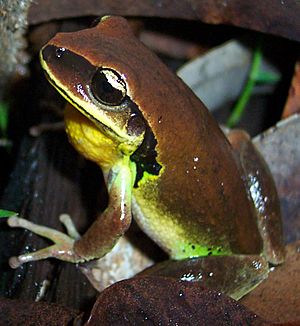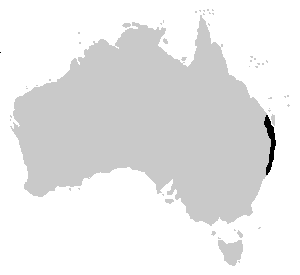Green-thighed frog facts for kids
Quick facts for kids Green-thighed frog |
|
|---|---|
 |
|
| Conservation status | |
| Scientific classification | |
 |
|
| Range of the green-thighed frog | |
| Synonyms | |
|
The green-thighed frog (Nyctimystes brevipalmatus) is a type of frog that lives in Australia. You can find it near the east coast of Australia, close to the city of Brisbane. This frog is special because of the bright colors on its legs!
Contents
What Does It Look Like?
The green-thighed frog is mostly brown. It has dark, almost black, stripes that run from its mouth all the way to its front legs.
The most interesting part is its thighs (the upper part of its back legs). They are usually a light blue or green color. These colorful thighs also have black spots on them.
Where Does It Live?
These frogs like to live near water. They prefer places with temporary ponds or puddles. These are bodies of water that might dry up during certain parts of the year.
Life Cycle of the Green-Thighed Frog
Green-thighed frogs have a fascinating way of growing up.
- They lay their eggs in the water.
- These eggs float together on the surface of the water.
- The tiny tadpoles hatch from the eggs very quickly, usually within one day.
- The tadpoles stay in their tadpole form for about 40 days.
- Most of them will change into full-grown frogs before they are 100 days old.
Why Is It Endangered?
Sadly, the green-thighed frog is an endangered species. This means there are not many of them left in the wild. The IUCN Red List keeps track of endangered animals.
There are several reasons why these frogs are in danger:
- Habitat Loss: People are cutting down the forests where these frogs live. They build roads and railroads in these areas. This destroys the frogs' homes.
- Fires: Bushfires can also harm their habitats and reduce their numbers.
- Pollution: Water and land pollution can make their homes unsafe.
- Invasive Species: Sometimes, new animals or plants are brought into their area. These invasive species can compete with the frogs for food or even eat them.
Protecting the places where green-thighed frogs live is very important. This helps them survive and thrive for the future.
See also
 In Spanish: Nyctimystes brevipalmatus para niños
In Spanish: Nyctimystes brevipalmatus para niños


